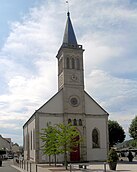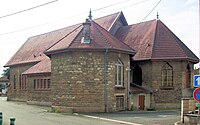Audincourt
| Audincourt | ||
|---|---|---|

|
|
|
| region | Bourgogne-Franche-Comté | |
| Department | Doubs | |
| Arrondissement | Montbeliard | |
| Canton | Audincourt (main town) | |
| Community association | Pays de Montbéliard agglomeration | |
| Coordinates | 47 ° 29 ′ N , 6 ° 50 ′ E | |
| height | 314-417 m | |
| surface | 8.76 km 2 | |
| Residents | 13,387 (January 1, 2017) | |
| Population density | 1,528 inhabitants / km 2 | |
| Post Code | 25400 | |
| INSEE code | 25031 | |
| Website | www.audincourt.com | |
 Audincourt Town Hall |
||
Audincourt is a French municipality with 13,387 inhabitants (as of January 1 2017) in Doubs in the region Bourgogne Franche-Comté . It is the capital of the canton of Audincourt in the arrondissement of Montbéliard . After Montbéliard, Audincourt, the fourth largest city in the Doubs department, is the most important center in the agglomeration. Audincourt is part of the Pays de Montbéliard Agglomération municipal association , which was newly created on January 1, 2017.
geography
Audincourt is located at 323 m , about four kilometers southeast of the city of Montbéliard (as the crow flies). The city extends in the south of the basin of Montbéliard, on the right bank of the Doubs , which flows here in a wide arc around the heights of the Bois de Voujeaucourt, on the northern edge of the extreme foothills of the Jura .
The area of the municipal area of 8.76 km² includes a section of the Montbéliard basin. The main part of the area is taken up by the Audincourt valley, which averages 325 m. It has a width of about 2 km. The western border runs along the Doubs, which describes a sharp bend in the old town center and changes its direction of flow to the west. From the course of the river, the community area extends eastward over the broad valley and the relatively gently rising slope to the adjacent heights, which are part of the foothills of the Table Jura . These heights are predominantly wooded: Grand Bois ( 400 m ), La Combotte ( 412 m ) and Grand Bannot , on which Audincourt's highest point is reached at 417 m. The plateau is subdivided by various valley hollows, which, however, show no above-ground flowing waters apart from the gland .
Audincourt includes the settlements of Les Cantons ( 335 m ) on the eastern edge of the Doubs and Les Champs Montants ( 363 m ) on the plateau east of the Doube valley. Neighboring municipalities of Audincourt are Montbéliard , Exincourt , Taillecourt and Étupes in the north, Dasle in the east, Seloncourt in the south and Valentigney , Voujeaucourt and Arbouans in the west.
history
Various traces indicate that the municipality of Audincourt was already settled in the Bronze Age. Audincourt is first mentioned in 1140 under the name Adincourt . The place name goes back to the Germanic personal name Adwin or Alda and the Latin word cortis (court) and thus means court of Adwin or court of Alda .
In the Middle Ages, the Audincourt area was divided into various estates. Both the Lords of Dasle, the Belchamp Abbey and the Saint-Maimbœuf Chapter in Montbéliard owned estates. The sovereignty of the area was on the one hand the Counts of Montbéliard, on the other hand the Lords of Blamont. With the incorporation of Blamont into the county of Württemberg-Mömpelgard (Montbéliard) in 1506, both parts were united. As early as 1523, the village of Dâlotte was united with Audincourt. In 1541 the Reformation was introduced and from then on Audincourt belonged to the parish Exincourt before it became its own parish in 1588.
A forge and ironworks was founded on the Doubs below Audincourt in 1616, which laid the foundation for the later industrial development of the community. The iron ore deposits in the area, the surrounding large forests (wood supply) and the hydropower of the Doubs formed the important factors for this location. During the Thirty Years War , the ironworks was set on fire in 1635, so that operations could not be resumed until 1650. With the annexation of the county of Montbéliard, Audincourt finally came into French hands in 1793.
With the opening of the Montbéliard – Morvillars railway on June 29, 1868, Audincourt was connected to the French railway network. In 1904 the tramway from Montbéliard to Hérimoncourt was opened, but operations were discontinued in 1932. Passenger traffic on the railway line was stopped in 1938, the last freight train on the remaining route to Dasle-Beaucourt station ran in 1990, before freight traffic from the direction of Montbéliard was also completely stopped in 1993. The railway line has been dismantled in places and is no longer passable.
The beginning of the 19th century was marked by industrialization, the expansion of the ironworks and the establishment of the Japy spinning and weaving mill in 1819. At the beginning of the 20th century, Peugeot founded a factory producing mechanical components for automobiles. Audincourt thus became the second most important industrial center next to the core city of the Montbéliard agglomeration. The crisis in the industry began in 1965 with the decline of the textile factories and continued from 1968 to 1971 with the closure of the ironworks. This led to a diversification of the industry and the establishment of new branches in the 1970s.
population
With 13,387 inhabitants (as of January 1, 2017) Audincourt is one of the largest municipalities in the Doubs department. From 1850 to 1926 the population showed a continuous strong growth. This was followed by a period of stagnation that lasted until after the Second World War. From around 1950, strong growth began again, so that the population quickly exceeded the 10,000 inhabitant limit. The population doubled by 1975. With almost 19,000 inhabitants, the previous high was reached in the mid-1970s. The economic crisis and the restructuring of industry in the Pays de Montbéliard from 1975 to 1990 led to many workers and families moving away. As a result, there has been a significant population decline. The downward trend has continued to this day in a weakened form. Since the peak, Audincourt has lost about 3,000 residents, a decrease of 17%.
Today almost the entire valley floor of the Doubs has been built over, with various smaller open spaces between the groups of buildings. The settlement area of Audincourt has grown together almost seamlessly with those of Arbouans, Exincourt, Taillecourt, Seloncourt and Valentigney.
| Population development | ||||||||
|---|---|---|---|---|---|---|---|---|
| year | 1962 | 1968 | 1975 | 1982 | 1990 | 1999 | 2011 | 2016 |
| Residents | 12,433 | 13,488 | 18,578 | 17,454 | 16,361 | 15,539 | 14,966 | 13,582 |
Attractions
- The Lutheran Church (Temple) was built from 1844 to 1846 according to plans by Jean Frédéric Fallot and replaced a previous building from the 17th century that was demolished in 1842.
- The Church of Notre-Dame de l'Immaculée Conception ( Immaculate Conception of Mary ) was built from 1930 to 1932 in the shape of a Latin cross according to the plans of architect Don Bellot . It was one of the first reinforced concrete churches in France. The design with lines and cubes without round elements (which are indicated on the inside as drawn polygons ) is remarkable . The windows are by Valentine Reyre. The church has been classified as a Monument historique since 2013 .
- The Sacré-Cœur ( Sacred Heart of Jesus ) church, built according to a design by the architect Maurice Novarina , dates from 1951 . The hall church with a semicircular end in the area of the altar is supplemented by a baptistery and a free-standing tower in the rear area of the church, each of which is connected to the building by covered corridors. The roof protrudes in the entrance area and is supported there by two columns, creating a kind of vestibule. The glass windows that run around the side walls and the chancel as well as the tapestry behind the altar are by Fernand Léger , the exterior mosaic over the entire width of the entrance area and the glazing of the baptistery were created by Jean Bazaine . This church has been classified as a Monument historique since 1996.
- Churches in Audincourt
The former Mairie (town hall) represents the architecture of the second half of the 19th century. Other secular structures include the Château Thévenot, which was built in the 18th century and now houses the municipal library, and the Château Peugeot (built by the Peugeot family at the beginning of the 20th century). The buildings of the Japy factories, built in the 19th and 20th centuries, bear witness to Audincourt's industrial past and are now used for cultural and recreational activities.
Economy and Infrastructure
Audincourt developed into an industrial community as early as the 18th century. The large industrial and commercial areas are concentrated in the Doubs valley above and below the old town center and at the entrance to the Gland valley on the border with Seloncourt. Today Audincourt offers more than 6300 jobs. The main employer is Faurecia (Peugeot SA), which employs around 1200 people in its three factories (manufacture of accessories for cars); in addition, numerous smaller companies specialize in the automotive industry. Other important branches of industry include construction, micromechanics, plastics and metal processing and a company that specializes in the manufacture of insulation materials. Numerous companies that are active in the service sector have also settled in Audincourt, such as trading and logistics companies, engineering offices, administrative, banking and insurance companies. There are also various large shopping centers, specialist shops and numerous retail shops for daily needs.
Audincourt has various educational institutions. It is the location of a college and two vocational schools. The community offers a wide range of cultural and leisure activities. It has a theater, a multiplex cinema, a cultural center, a sports hall and numerous sports fields as well as an outdoor swimming pool.
The village is very well developed in terms of traffic. It is on the main road N437, which leads from Belfort via Sochaux to Pont-de-Roide-Vermondans . The closest connection to the A36 motorway is around three kilometers away. Other road connections exist with Voujeaucourt, Beaucourt , Porrentruy and Valentigney. Audincourt is connected to the city of Montbéliard and the surrounding communities by several bus routes. The Montbéliard – Morvillars railway line , which last only ran from Montbéliard to Audincourt, is no longer passable.
Partnerships
Audincourt has had a community partnership with Dison in Belgium since 1961 .
Personalities
- Henri Auguste Ménégaux (1857–1937), ornithologist, malacologist and zoologist
- Roger Hug (1913–1996), football player and coach
- Daniel Beretta (* 1946), composer, singer, actor and voice actor
- Annie Genevard (born 1956), politician
- Camel Meriem (* 1979), soccer player
- Benoît Pedretti (* 1980), football player
- Aksel Aktaş (* 1999), football player
Web links
Individual evidence
- ↑ See "Audincourt: le temple" , on: Les temples ou églises luthériennes de France , accessed on January 23, 2016.
- ↑ Monuments historiques - Audincourt, Notre-Dame , accessed December 20, 2017
- ↑ Monuments historiques - Audincourt, Sacré-Cœur , accessed December 20, 2017




